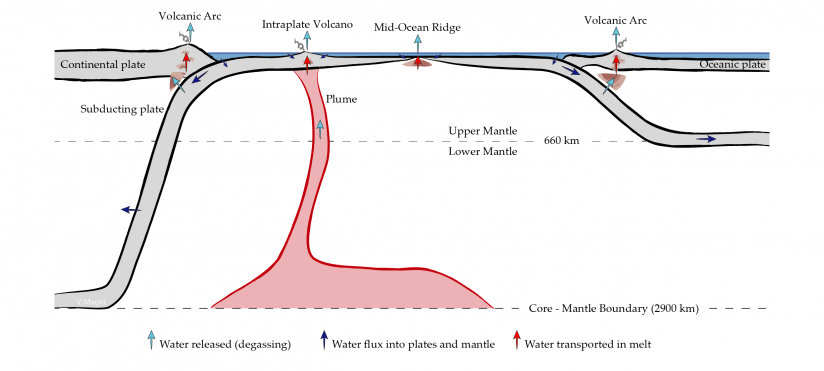The transport of water from Earth’s oceans to Earth’s deep interior occurs via subduction, which is a well-known process. Mineral physics, seismic studies and measurements on fluid inclusions in diamonds indicate that the mantle between 410 and 660 km depth likely contains several oceans of water. However, some parts of this region may be more hydrated than others.
In particular, the location of wetter regions should depend on the location of slabs at depth, the volume of water that these slabs carry downward from the surface, diffusion and mixing of water within the mantle, and on the regional history of mantle convection (e.g., subduction dynamics, presence of plumes, broad-scale mantle flow, and dehydrating processes such a mid-ocean ridge or plume volcanism). The wetter regions of the mantle will melt more easily, which affects volcanism, and will have lower viscosity, which affects mantle dynamics.
Plate tectonic reconstruction models tell us where subduction occurred in the past ~300 Myr and provide estimates of the ages and velocities of subducting plates. Numerical models tell us how plate ages and velocities are related to the transport of water into the deep mantle. By linking these tools, we can estimate where subducted water is likely to be present in the mantle today.
This project will use tectonic reconstructions and numerical modelling, with a goal toward making predictive maps of the wet and dry areas of the mantle.
This MSc project will involve close collaboration with multiple CEED scientists. The student will run simulations to predict the location of slabs in the mantle, based on plate reconstruction models, and estimate the amount of water they could carry.
The student will carry on a parametric study to investigate how the predictive maps of water in the mantle depend on parameters such as slab sinking velocity, slab water content, slab deformation within the mantle, and water solubility.
Recommended skills
- Basic knowledge of computer programming in order to use the remote super-computer, setup the model runs, and handle the resulting data sets
- Basic knowledge of mantle convection dynamics
Learning outcomes
- Computer programming
- State-of-the-art plate tectonic reconstruction models
- Post-processing and visualization of large datasets
- Broad understanding of multi-scale mantle convection and the integration of multiple datasets
- Experience writing and publishing a scientific manuscript

Click here for a bigger version of the picture.